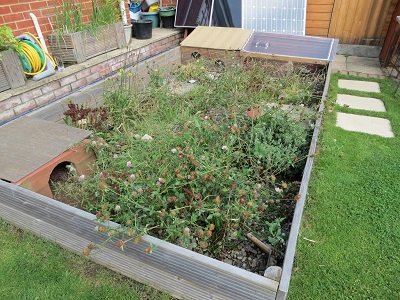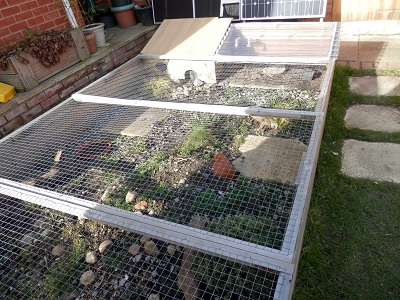Outside Housing and Enclosures
How To Make an Outside Enclosure
Firstly you will need to allocate as much space as possible for your tortoise enclosure. The bigger the better, as in the wild tortoises will roam huge distances. The area needs to be in full sunlight and on well-drained soil, not grass.

Next you need to decide on what materials to use for the boundaries. We use decking boards for ours. Bricks are another good alternative. Whatever you choose to use needs to be opaque to stop your tortoise trying to walk through it and ideally sunk someway into the ground to stop your tortoise escaping by tunnelling out. The height of the perimeter wall needs to be at least twice as high as your tortoise is long to avoid them climbing out.
Security
Your enclosure will need to be predator proof. Rats, foxes and large birds will all attack a tortoise, particularly a small one. Dogs can be a particular danger to tortoises who they may see as play things, but their teeth can pierce a tortoise shell causing serious damage. Our enclosures are completely covered with wire mesh attached to wooden frames that are easily removed for access.

Unfortunately natural predators aren't your only concern. Thefts of tortoises are not uncommon. Take precautions to secure the area where your tortoises are kept by installing locks to gates and your tortoise's overnight hide or accommodation. As much as possible try to keep them out of view of casual passers by and never advertise the fact that you have tortoises on your property.
Hides And Warming Areas
Within the enclosure there needs to be a hide / covered area where a tortoise can retreat from the sun or seek protection from bad weather. In addition one of the most beneficial structures to have in your enclosure is a warming area. A greenhouse is perfect, but if you don't have the space for a full size greenhouse then it's fairly simple to make a mini one. A sheet of polycarbonate as a roof and a few bricks for walls will make a mini greenhouse or use a gardener's cloche or cold frame. The tortoise can come and go from the area as needed for thermoregulation. Our warming area is attached to the side of the hide and has the roof angled towards the sun. Our tortoises will leave their hide in the morning and sit under their warming area for as long as they need and returning throughout the day as and when they want to. Even in the height of summer UK temperatures don't often reach anything like the temperatures that tortoises would experience in the Mediterranean. But these mini greenhouses can increase temperatures by around 10 degrees centigrade and this can make a huge difference to a tortoise's behaviour, feeding patterns and general health. If you are lucky enough to have space for a full size greenhouse and have access to an outside power source then a basking lamp can be suspended from the ceiling so that even in the much cooler spring and autum your tortoise can still have access to the outside, but can come into a warm dry greenhouse when needed.
How To Make An Interesting Enclosure
Your tortoise will also benefit by having some mounds, slopes and rocks not just flat surfaces. Tortoises will use these mounds to help angle themselves towards the sun when basking. Mounds and slops will also break the tortoise's line of sight giving them reason to explore, help excercise leg muscles and generally make the environment more interesting.
Planting your enclosure with non-toxic plants like Carex grasses and shrubs like Rosemary, Lavender and Thyme will provide shade from the sun and make good hiding places. My young juveniles love to bury themselves down under the long wispy leaves of a Carex plant. The substrate for the enclosure needs to be well drained and free of grass. We use a mix of 50/50 play sand and topsoil. To this we add a generous amount of limestone chippings, which firstly aid with drainage and secondly will hopefully over time add some natural calcium into the soil. Other large rocks and logs are added to add interest and to help keep claws short. A variety of seeds for edible weeds are easily available on the internet and as large a selection as possible of these should be planted to provide food that the tortoises can graze on.
A water bowl large enough for your tortoise to sit in should be available at all times.